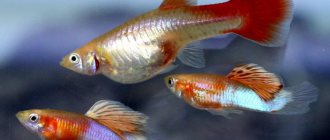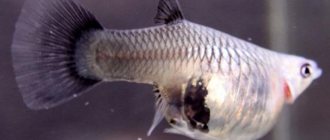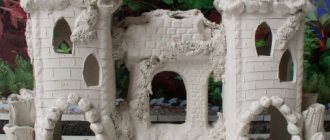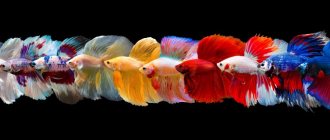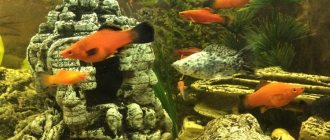Neons are small, beautiful, active aquarium fish that reproduce by spawning. Neons reach sexual maturity at the age of 6-8 months and retain reproductive functions until 4-5 years. To get offspring from these fish, you need to create special conditions for them. If everything is done correctly, you can see how neon fish reproduce. The most favorable time for spawning is from October to January.
DESCRIPTION, APPEARANCE, BUILDING
Neons are highly prized among aquarists. These fish are a real decoration for an aquarium. There are bright neon stripes on their body. Despite the bright colors, the fish do not distract, but, on the contrary, emphasize the beauty of the design created in the aquarium.
Neons are schooling fish and look great in an aquarium. Their bright shiny red or blue stripes along the body flash spectacularly in reflected light. This distinctive feature, which gives the fish a resemblance to neon signs, was the idea for their name.
The body of the fish is elongated and slightly flattened on the sides. On average, the length of neons is from 2.5 to 5 cm. The fish have a relatively small mouth, transparent fins, of which the anal one is longer than the dorsal one. Fishes of the order Characinidae are characterized by the presence of an adipose fin. It has no bony rays. The adipose fin is not paired and is located behind the dorsal fin.
It is noteworthy that in males the neon stripe is a straight line, while in females it has a slight break in the middle. Therefore, a specialist can easily distinguish a male from a female.
Most often in aquariums you can see red, blue and black neons.
black neon
red neon
blue neon
Selection of partners
The highest productivity is observed in neons aged 10-12 months. 1 female and 2-3 males are placed in the tank where the spawning will take place. For successful reproduction, you need to choose the right fish and know how to distinguish a female from a male.
It is not easy to distinguish a female from a male neon, but if you pay due attention you will notice the differences.
Males are smaller in size than females. Their body length is 0.5 cm shorter. They are more slender, unlike large and pot-bellied females. A pregnant neon, a female carrying eggs, enlarges even more in the abdominal area immediately before spawning; the male’s swim bladder becomes more pronounced.
For breeding to be successful, you need to select only those individuals that meet the following parameters:
- appearance – active fish, healthy, without torn fins or other similar nuances;
- color – rich, bright, juicy;
- behavior - playful, curious, good appetite.
During the 2-week period of fish relocation, it is not recommended to give them tubifex. This type of live food contains a lot of fat, which can negatively affect the health of the fish and their future offspring.
STORY
For the discovery of neons and their appearance in our aquariums, we should thank the French researcher Auguste Rabot. It was he who first discovered these fish in Peru, in the Putumayo River. The beauty of the fish literally bewitched Auguste. Being a very enterprising man with a touch of adventurism in his soul, he decided that he could make good money by exporting them.
In 1935, the first copies of neon were first delivered to Europe and the USA. Aquarists really immediately fell in love with these fish, they became very popular. The fact that neons did not require complex maintenance was an additional plus. Auguste Rabot received huge dividends from his find. The fact is that in artificial conditions problems arose with the breeding of neons. In the first years, no one simply succeeded, so Rabo became a monopolist in the supply of neon to Europe.
Some of the first copies were donated for advertising purposes to William Innesi, an aquarium enthusiast and popularizer. He, in turn, gave the fish to his friend, George Myers, who made the first scientific description of a new species - blue, or ordinary neon, which he named in honor of his friend.
For the first time, it was possible to obtain offspring under artificial conditions in Germany. This phenomenon was even called the “German miracle.” Over time, it became clear that the secret of this “miracle” was in the softness of the water that was used to contain neons. The information obtained served as an impetus for new research that discovered the mechanisms of influence on the successful reproduction of neons.
Water composition
The water in the container where spawning will occur must be purified and soft. A mixture of aquarium water and distilled water is suitable. You can also use tap water, but it should be collected several days in advance and then kept at room temperature. Tap water contains harmful impurities, and during settling they evaporate. Water is poured into the spawning area at a temperature of no lower than 22 and no higher than 25 degrees.
Water hardness is very important for successful fertilization. This indicator should have a value from 0.5 to 4, best of all - about 1. Optimal acidity - 5.5-6 units. With these parameters, bacteria practically do not multiply, and the eggs are in comfortable conditions. You can increase the acidity level of water by adding a decoction of one of the components:
- peat;
- alder cones;
- oak bark.
You can also buy a special acidifying agent at the pet store.
HABITAT
The birthplace of neon is South America. In Peru, Colombia, and Brazil you can find these amazing fish in their natural habitat. The element of neon is calm waters. Therefore, they prefer slow-flowing tributaries of large rivers, the waters of which are rich in humic substances, to fast flows, which gives them a brown tint. The optimal conditions for the life and reproduction of neons are soft and acidic water. These are the conditions that are created in rivers flowing in the shadow of tropical forests. Decaying leaves, regular rains, and a large layer of silt make the water soft and acidic.
Neon habitat in nature
Aquarium
Can be of any volume, preferably at least 40 cm in length and 30 cm in height.
Neon blue (Paracheirodon innesi) in aquarium 1
The content is relatively simple. The aquarium must be equipped in accordance with the conditions of the natural reservoirs where they are found. The lighting is moderate, with shadows. The soil is dark (basalt chips, boiled peat) and driftwood, densely planted with plants (Thai fern, cryptocorynes, pinnate, Java moss, etc.), with free places for swimming.
Neon blue diamond (Paracheirodon innesi) in an aquarium
They are unpretentious in terms of water composition, unless subsequent dilution is taken into account, and significant temperature fluctuations must be avoided. Prefers not too hard, slightly acidic water.
Neon blue (Paracheirodon innesi) in aquarium 2
Water parameters:
Temperature: 21 - 28° C pH: 4.0 - 7.5 Hardness: up to 12° dGH
Keep in mind that they, like most fish in this area of South America, can withstand some increase in nitrites and nitrates well, but do not tolerate large amounts of fresh water during water changes! It is better to replace in small portions, but more often.
CONDITIONS OF DETENTION
Neons are very popular aquarium fish. To make them feel comfortable, it is recommended to keep them in flocks of at least 5 individuals. When kept alone or in pairs, fish may lose tone and color, and their lifespan may also be noticeably shortened.
Schooling fish always stay in a group. Most often, neons swim chaotically and randomly, however, if they are frightened, the fish form a dense school and begin to swim almost synchronously.
The optimal water temperature in the aquarium for keeping them is +20…+26 °C, pH 6-7, total hardness is 6-15 °dH. Fish can live in water with higher hardness. Over the long history of breeding, they have adapted well to conditions different from their natural habitat.
The average lifespan of neons under artificial conditions is 3-4 years. The higher the temperature, the shorter the lifespan. Neons prefer to swim in the lower layers. They do not spoil the vegetation in the aquarium and do not tear it out by the roots, like other fish.
Do not forget that in their natural habitat, fish prefer twilight. Therefore, it is not recommended to use bright, powerful lamps for lighting in an aquarium. Lighting should be dim so as not to stress out the neon lights. But you can choose any materials as a primer. Dark soil - for example, pebbles or dark sand - will help to emphasize the spectacular appearance of the fish.
When arranging an aquarium, care should be taken to have filters of sufficient power that could provide complete biological and mechanical purification of water. The presence of a compressor is also welcome.
To create the most comfortable living conditions for neons in the aquarium, you should change 25-30% of the water once a week with a parallel siphon of soil.
Neons are small schooling fish, accustomed to hiding in shelters in case of danger. Therefore, when designing an aquarium, care should be taken to create such “secret” zones. For these purposes, you can immerse driftwood or shards of ceramic products at the bottom of the aquarium. A good option is areas of dense thickets of long-stemmed plants (elodea, cabomba, vallisneria, etc.). It is better to cover the aquarium with a lid or protective glass, as the fish can jump out of the aquarium.
After spawning
After a couple of days, or more precisely, 36–38 hours, the juveniles hatch. Not all eggs survive. Some of the neon eggs may be affected by the fungus, or simply die during development. It is recommended to separate the fertilized eggs after 12 hours. This can be done using a pipette. Place the fertilized eggs in another container, as the risk of infection is very high.
Neon caviar
An important factor is lighting. For neon fry, light is destructive. For several days after birth, they cannot see well. It is worth leaving one open corner where the light will flow.
FEEDING NEONS
Properly selected food plays an important role. Its main characteristics are nutritional value, content of essential vitamins, and mineral content. Also, its shape should be convenient for neon to eat. To feed the fish, dry and freeze-dried food is used, which should be alternated with live or frozen food (bloodworms, brine shrimp, small daphnia, coretra, etc.). One day a week should be a fasting day. Otherwise, constant feeding of protein foods leads to obesity in the fish. Food should be given once or twice a day so that the neons eat it within a few minutes.
What are the dangers of overfeeding and lack of a fasting day? Due to obesity, cysts form and the fish become infertile. General health worsens, immunity drops, and eventually neon dies.
Appearance of fry
A day after the completion of spawning, the larvae hatch. Without waiting for this process, you should inspect the eggs and remove those that have a whitish color and opaque structure. These are dead specimens, nothing will hatch from them, and if you leave them in the spawning area, the water will be spoiled.
For the first 4 days, the fry sit motionless, feeding on what is in the yolk sac. When its contents run out, which happens around the fifth day, the babies begin to move around in search of food. At this time, you can already feed them zooplankton.
During the first month of life, the fry have poor orientation, but they have developed phototaxis. Thanks to this feature, the fish feel where the illuminated areas are. Thus, you need to darken almost the entire container, leaving a small part open. Plankton will accumulate in the light, which young neons readily eat.
COMPATIBILITY
Despite their relationship with piranhas, neons are one of the most peaceful and non-aggressive fish. They get along well with other peaceful, medium-sized aquarium fish. Their neighbors may well be guppies and various species of viviparous carp, as well as rasboras, ancistrus, tetras, cardinals, etc. Amphibians and large aquarium inhabitants can react to neons as potential food. When deciding on a location, you should understand that if the neon can fit into another fish’s mouth, it can be eaten. Neons should not be allowed to be adjacent to territorial fish and predator fish.
Features of mating games
When males and females find themselves in the same tank, they will fussily move around it for a while, swimming above the leaves. Neons breed mainly at dawn, so it is recommended to connect them in the evening so that they have time to get acquainted.
The mating dance of veiled neons.
As soon as the female begins to spawn, the males begin to attack her. The one who catches it first will win. When the male overtakes the female, he touches her tightly, and they turn at the same time. The dorsal fin lies on the female. When the right moment comes, the fish bend synchronously, and the moment the eggs and sperm fall out coincides.
NEON FISH REPRODUCTION AND BREEDING
If you want to start breeding neons, then you have to take care of creating the appropriate conditions. Spawning requires very soft (1-4 °dH), slightly acidic water with pH= 6.0 - 6.5 and a temperature of +23...+25 °C.
Neon breeding must be strictly controlled to avoid endangering the eggs. Producers must be placed in separate containers several weeks in advance and intensively fed with live food.
During the normal period, neons have weakly expressed sexual dimorphism. But during the breeding season, visible external changes occur: in females the abdomen enlarges and becomes rounded, in males the swim bladder shifts towards the anus.
male and female before spawning
normal male and female
Before placing a pair of neons for spawning, it is advisable to give them several short dates so that the fish get used to each other. The female is able to lay eggs weekly, while the male is ready to fertilize her 2 times less often.
It is not necessary to lay soil in an aquarium intended for spawning. Its volume must be at least 6 liters and no more than 10 liters. The best shape of an aquarium for breeding is elongated (rectangular) with a height of no more than 30 cm. It is necessary to ensure ideal sterility and the complete absence of light; neon eggs cannot tolerate it. A lump of synthetic threads can serve as a spawning substrate. Another affordable option is a separator net that can be placed on the bottom of the aquarium.
It is best to introduce neons ready for spawning into the aquarium in the evening, several hours before turning off the lights. Two males are usually placed with a female. During one spawning, an adult female lays up to 200 eggs. Spawning occurs in the early morning hours, as soon as it begins to get light. The spawners must be removed after the end of spawning so that the eggs are not damaged.
Not every egg is destined to become a fry. Some of them will not ripen. The eggs are also affected by fungi. To preserve the maximum possible number of eggs, special antifungal drugs are used. Already 9-10 hours after spawning, spoiled eggs can be identified - they will be white. They should be carefully removed using a pipette. If this is not done, they will continue to decompose, affecting adjacent viable eggs.
The incubation period lasts for 24 hours. Larvae emerge from the eggs. They will sit on the bottom and walls of the aquarium for several days. After 3-4 days, the yellow shell will dissolve and the fry will begin to swim freely. From now on they need proper nutrition. The fry should be fed with live dust, for example, rotifers and ciliates. Feedings should be frequent, and slaves should not starve. After about 5-7 days they need to be transferred to Artemia nauplii. Changing the diet should not be delayed - the sooner brine shrimp are introduced into the diet, the more fry will survive. As young neons grow, you should add regular water with your hardness to the aquarium in small portions so that it gets used to it. In this way, the fish adapt to standard living conditions. The lighting in the nursery is also gradually increasing.
Today it seems surprising that aquarists of the 20th century could not reveal the secret of neon reproduction under artificial conditions for a long time. This process is not particularly difficult. Any amateur, armed with information available on the Internet, can quite successfully breed these beautiful fish on his own.
Preparing the spawning tank
While the female and male are preparing for spawning, it is necessary to prepare a spawning tank for them - a small aquarium or an all-glass container with a volume of 6-10 liters, which is easy to wash and disinfect. It is best to use an elongated aquarium about 40 cm long for this. The prepared container should be disinfected with a weak solution of potassium permanganate, and then rinsed thoroughly with clean water.
The walls of the spawning area should be shaded with old newspapers or thick paper. You can leave the front surface of the vessel open and watch the fish spawn through it.
The light in the spawning tank should be dim and not directed. The top of the vessel should be covered with a glass lid, since during mating the fish are very active and can jump out of the container.
There is no need to pour soil into the spawning tank; it is best to put a piece of Java moss, a nylon mesh, tangled fishing line, a washcloth or willow roots collected in water on the bottom. You can attach several bushes of cryptorina or fern to the bottom.
IMPORTANT: Catfish and snails, which will happily feast on fresh eggs, should not be allowed into the spawning area. In a short time they can clear all the internal surfaces of a reservoir of eggs.
Return to content
Neon diet
Any inhabitants of the aquarium must be fed in a balanced and timely manner. Any fish is naturally omnivorous and voracious, and the only one who can control the amount is the owner. The diet should include both dry and live food. You can buy them at a pet store, from suppliers, or prepare them yourself.
Blue neon, like any other fish, is not averse to eating live food.
Neon fish usually grab food in the water density, and less often remove food from the surface of the water. The size of their mouths is very small, so you need to carefully monitor whether the babies are eating well. If the granules are too large, the fish may not cope and end up without a meal.
You can't give fish a buffet. One meal - one type of food (either dry or live), otherwise the harm to health will be irreparable . Neon gourmands can absorb food without stopping - nature has endowed fish with this property for a good purpose. But for aquarium inhabitants, gluttony is destructive. A neon fish can fill its belly to such an extent that death becomes inevitable. You need to give your baby as much food as he can eat in 2-3 minutes. The rest needs to be fished out, otherwise the food will sink to the bottom and begin to decompose, contaminating the water with ammonia.
It is advisable to pre-freeze and crush live food, and only then give it to the fish. Neons are very fond of bloodworms, daphnia, and tubifex. All this must be frozen, since live food is often infected, and the fish are poisoned to death.
Video: Feeding Blue Neons
If there are other fish adjacent to the neons, you need to observe whether all the pets have time to enjoy the food. Neons are more “compliant” than other species and, when fighting for food, as a rule, remain a voluntary loser. Several such defeats - and the fish faces starvation.

